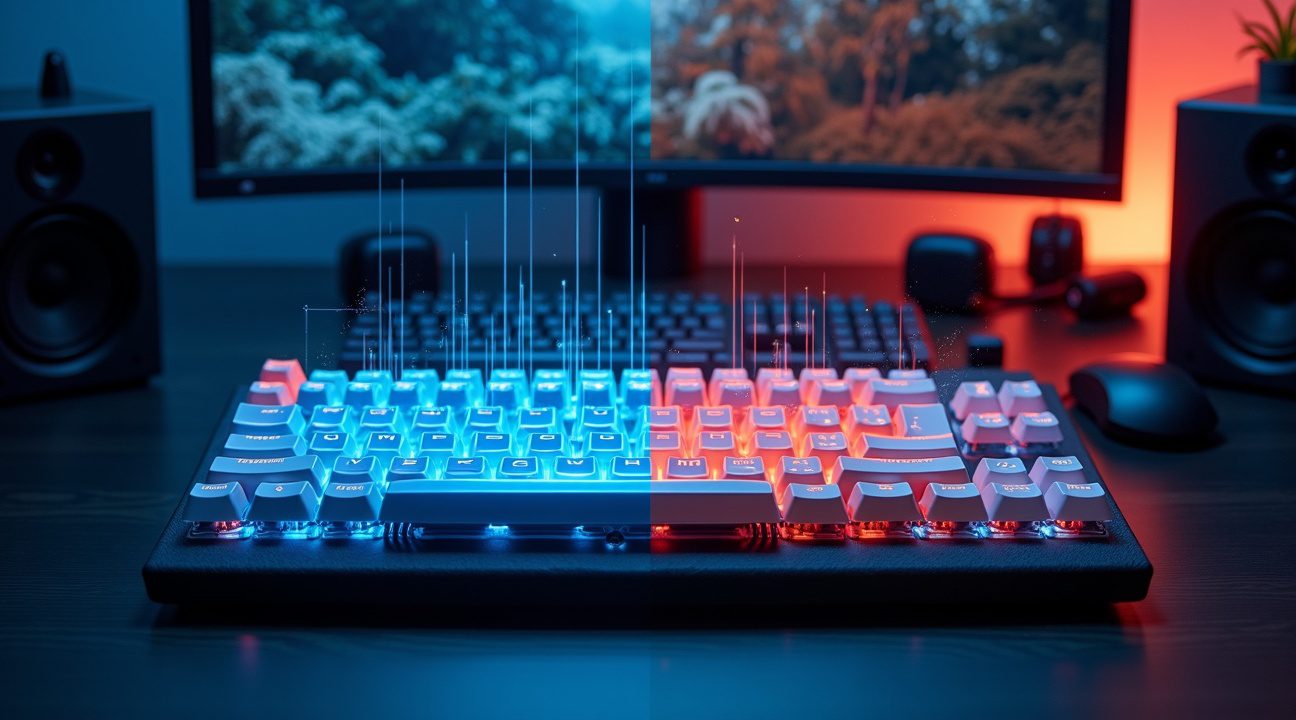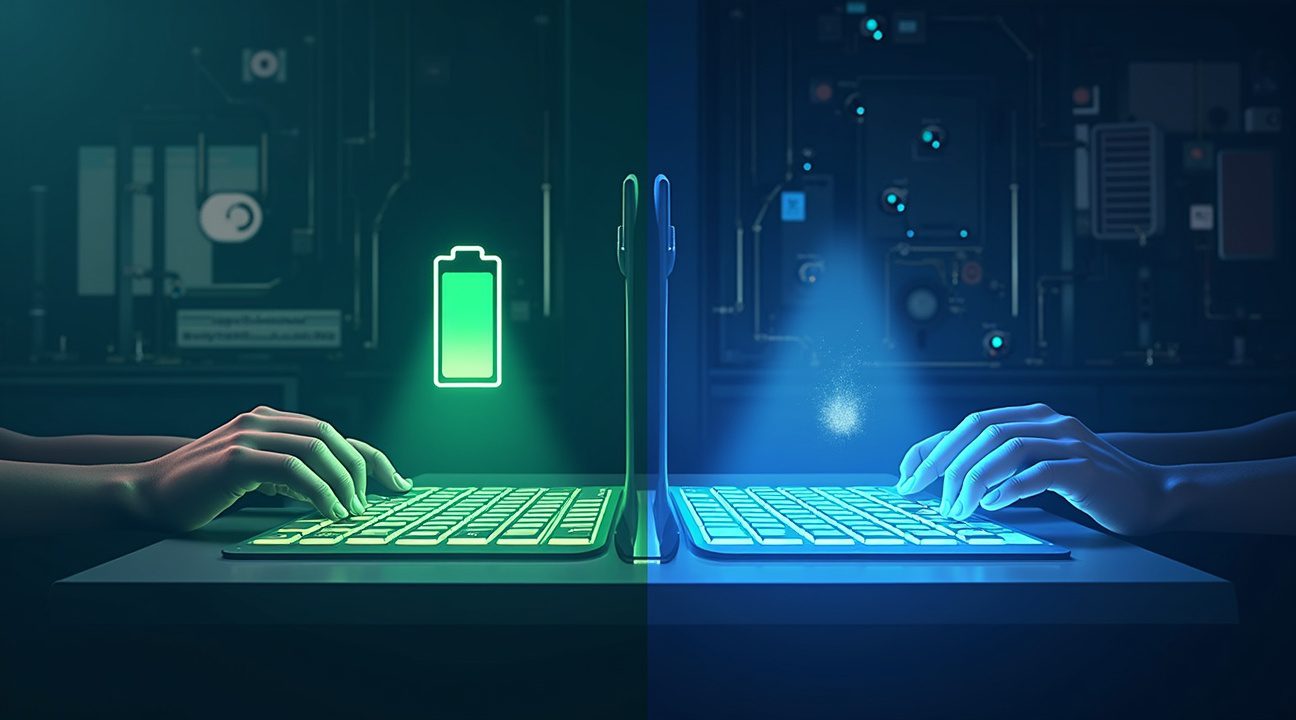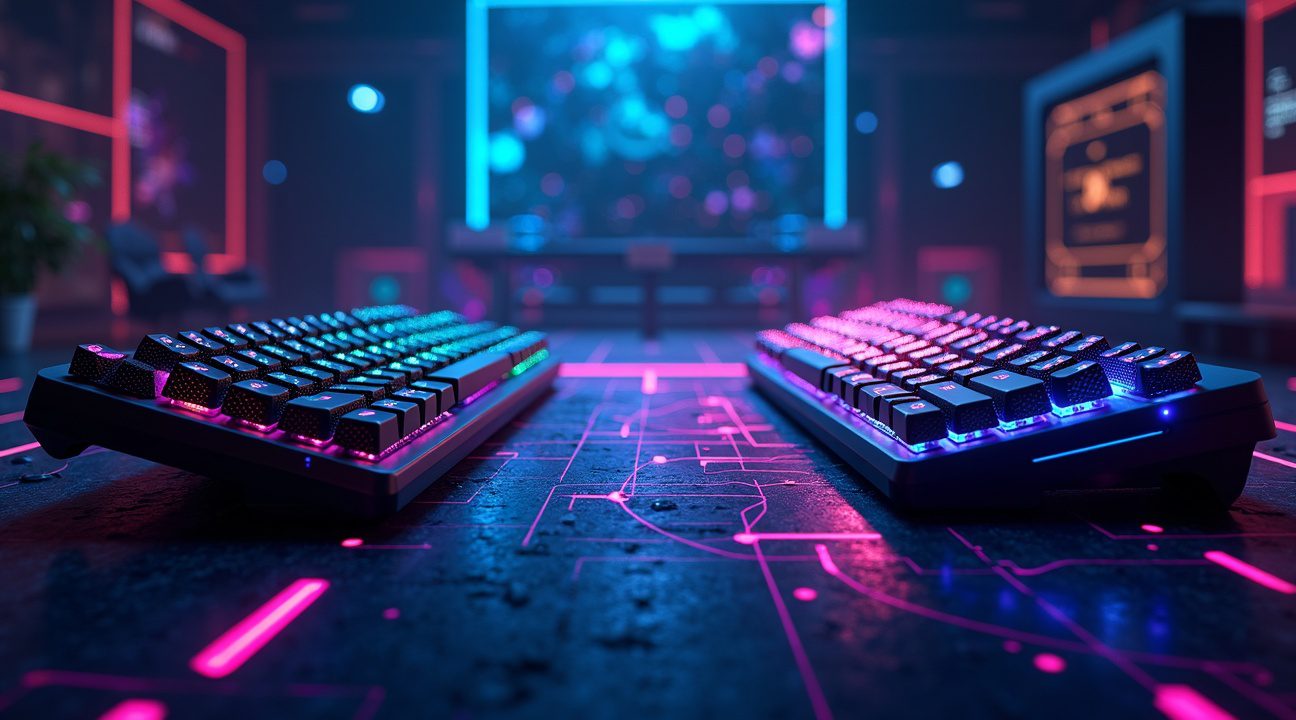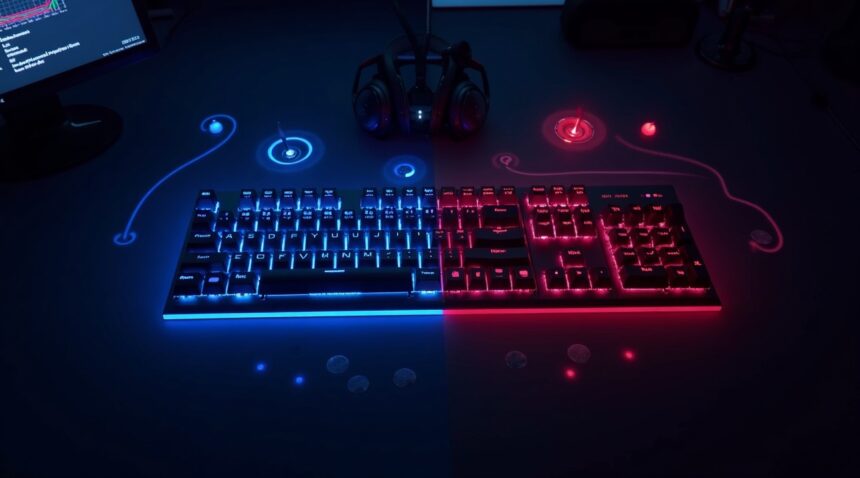Optical switches deliver superior raw speed compared to Hall effect switches, but these microsecond differences barely affect real-world gaming or typing performance.
Both technologies provide substantial advantages over traditional mechanical switches. Their main benefits center on customizable actuation points, analog input capabilities, and extended durability rather than pure latency performance.
Key Takeaways
- Speed differences are negligible – Both optical and Hall effect switches respond faster than human reaction times, making the technical latency advantage of optical switches imperceptible to most users.
- Environmental stability favors optical switches – Light-based detection remains consistent across temperature changes and magnetic interference, while Hall effect switches can be affected by external magnetic fields and temperature fluctuations.
- Power consumption differs significantly – Hall effect switches consume less power, making them better for wireless keyboards, while optical switches require more energy to maintain their LED systems.
- Both technologies excel in customization – Adjustable actuation points, rapid trigger functionality, and analog input capabilities provide more practical gaming benefits than raw speed differences.
- Professional preference varies by individual needs – Competitive gamers choose based on consistency, customization options, and environmental reliability rather than purely on latency specifications.
To learn more about these technologies and how they compare in detail, check out this informative guide on Optical vs Hall Effect Switches.
Why Optical Switches Are Technically Faster Than Hall Effect – But Does It Matter?
When comparing optical and Hall effect switches, latency becomes a critical factor that manufacturers love to highlight in their marketing campaigns. Optical switches do hold a technical advantage in raw response times, but the real-world impact of this difference deserves closer examination.
Optical switches achieve their speed advantage through their fundamental operating principle. Unlike Hall effect switches that rely on magnetic field detection, optical switches use light beams that get interrupted when a key is pressed. This light-based detection eliminates the need for complex signal processing that magnetic sensors require, resulting in reduced latency from keypress to signal registration.
Hall effect switches aren’t slow by any means. They feature minimal debounce delay compared to traditional mechanical switches, which makes them significantly faster than standard membrane keyboards. The magnetic detection system responds quickly to positional changes, but it still requires a brief moment to process the magnetic field variation and convert it into a digital signal.
The Performance Reality Check
The actual latency difference between these technologies typically measures in microseconds rather than milliseconds. Most users, including competitive gamers, struggle to perceive differences this small. Response times for both switch types fall well below the threshold of human reaction time, which averages around 200–250 milliseconds for visual stimuli.
Both optical and Hall effect switches support features that matter more to gaming performance than raw latency:
- Analog input capabilities that allow variable pressure sensitivity
- Adjustable actuation points for customized trigger distances
- Consistent performance without mechanical degradation over time
- Elimination of contact bounce that affects traditional switches
Gaming manufacturers emphasize these latency differences because they represent measurable technical specifications, but the practical benefits lie elsewhere. Adjustable actuation proves more valuable than microsecond improvements, as it allows users to fine-tune their keyboards for specific games or typing preferences.
Professional esports players occasionally report preferences for optical switches, but their choice often stems from factors beyond pure speed. The consistent actuation force and customizable trigger points frequently matter more than the theoretical latency advantage. Hall effect switches offer similar customization options while providing excellent durability through their non-contact magnetic operation.
The marketing focus on speed specifications can mislead consumers into believing that switch type alone determines gaming performance. Factors like keyboard firmware optimization, USB polling rates, and system-level latency have greater impact on overall responsiveness than the choice between optical and Hall effect technology.
Both switch types excel in competitive gaming scenarios where consistent performance matters more than absolute speed. The reliability and customization options they provide create more noticeable improvements to gaming experience than the small latency differences between them.
The Technology Behind Each Switch Type – Magnets vs Light
Hall effect switches harness the power of magnetism to register keystrokes through sophisticated magnetic field detection. Named after physicist Edwin Hall who discovered the underlying principle in 1879, these switches incorporate a Hall sensor that monitors changes in magnetic fields. When I press a key equipped with this technology, the movement alters the magnetic field around the sensor, creating a measurable electrical response that translates into precise input detection.
The magnetic approach offers remarkable accuracy in measuring keystroke depth. Unlike traditional mechanical switches that simply register on or off states, Hall effect switches can detect exactly how far I’ve pressed each key. This analog input capability opens up new possibilities for gaming and typing, allowing for nuanced control based on pressure and depth rather than binary activation.
Optical Technology and Light-Based Detection
Optical switches take a completely different approach by utilizing infrared light beams for keystroke detection. These switches contain a light source and a photodetector positioned across from each other within the switch housing. When I press a key, the switch stem interrupts the light path between these components, triggering the photodetector to register the keypress.
The precision of optical detection rivals that of magnetic systems, offering several key advantages:
- Elimination of physical contact between components reduces mechanical wear
- Faster response times due to light-speed detection
- Consistent performance that doesn’t degrade over time
- Reduced susceptibility to dust and debris interference
Advanced Features Shared by Both Technologies
Both Hall effect and optical switches support analog input functionality, enabling keyboards to measure actuation distance with remarkable precision. This capability allows me to customize actuation points based on personal preferences or specific gaming requirements. Whether I need shallow activation for rapid-fire gaming or deeper presses for deliberate typing, both technologies accommodate these adjustments.
Rapid trigger functionality represents another shared advancement between these switch types. This feature enables dynamic customization of reset points, allowing keys to register repeated inputs faster than traditional mechanical switches. For competitive gaming scenarios where speed matters most, both magnetic and optical technologies can significantly reduce input lag and improve response times.
The analog nature of both systems means I can program different actions based on how deeply I press each key. Light presses might trigger one function while deeper presses activate entirely different commands. This programmable depth detection transforms keyboards from simple input devices into sophisticated control interfaces.
Both technologies excel at maintaining consistent performance over extended use periods. Hall effect switches avoid the contact wear that plagues traditional mechanical switches, while optical switches eliminate physical friction entirely. This durability advantage means keyboards equipped with either technology typically maintain their initial performance characteristics much longer than conventional alternatives.
The precision offered by both magnetic and optical detection enables manufacturers to create keyboards with incredibly low actuation forces and minimal travel distances. These characteristics prove particularly valuable for users who type extensively or engage in competitive gaming where every millisecond counts.
Speed enthusiasts particularly appreciate how both technologies support customizable actuation and reset points. Rather than being locked into fixed activation distances, I can adjust these parameters to match my typing style or gaming preferences. This flexibility represents a significant advancement over traditional mechanical switches, which offer limited customization options.
Both Hall effect and optical switches demonstrate how modern keyboard technology has evolved beyond simple mechanical activation. By leveraging magnetic fields or infrared light, these systems provide the precision, speed, and customization options that modern users demand from their input devices.
Consistency and Reliability – Where Optical Switches Take the Lead
When I examine the consistency factors between these two switch technologies, optical switches demonstrate clear advantages in maintaining uniform performance across various conditions. The light-based actuation mechanism inherently provides more stable operation since light beams aren’t affected by temperature fluctuations or humidity changes that can impact other switching methods.
Optical switches deliver exceptional consistency because their infrared light detection system operates independently of environmental variables. Temperature changes that might affect magnetic field strength in Hall effect switches don’t influence the optical beam’s behavior. This translates to identical actuation points and travel distances regardless of whether I’m gaming in a cold basement or a warm room during summer.
Environmental Resistance and Performance Stability
The key differentiator lies in how each technology responds to external conditions. Optical switches maintain their precision because they’re immune to magnetic interference from nearby electronics, speakers, or other magnetic sources. I can position my keyboard next to powerful speakers or multiple monitors without worrying about performance degradation.
Hall effect switches face several environmental challenges that can affect their reliability:
- Temperature variations can alter magnetic field strength, leading to inconsistent actuation forces
- External magnetic fields from electronics can interfere with the sensor’s detection capabilities
- Magnetic field strength variations between production batches can create noticeable differences in switch feel
- Dust and debris accumulation around magnetic components may impact long-term performance
According to Razer’s testing, optical switches demonstrate more linear and consistent travel distance measurement compared to Hall effect switches. This consistency proves crucial for competitive gaming where split-second timing matters. The precision advantage becomes particularly evident during rapid key combinations or when executing complex macros that require exact timing.
Optical technology eliminates the magnetic field variables that can introduce inconsistencies in Hall effect switches. The infrared beam maintains consistent properties across millions of actuations, ensuring that the first keypress feels identical to the ten-millionth. This reliability factor makes optical switches particularly appealing for professional applications where consistent performance is non-negotiable.
Manufacturing consistency also favors optical switches since producing uniform light sources and photodetectors is more straightforward than ensuring identical magnetic field strengths across thousands of switches. The variances found in Hall effect switches could impact their precision and reliability, especially under competitive conditions where milliseconds determine victory or defeat.
Long-term durability testing reveals another advantage for optical switches. Since they don’t rely on magnetic components that can weaken over time, optical switches maintain their original performance characteristics throughout their lifespan. Hall effect switches may experience gradual changes in magnetic field strength, potentially leading to slight variations in actuation force or travel distance over extended use periods.
The immune nature of optical switches to external factors creates a more predictable typing and gaming experience. I don’t need to worry about electromagnetic interference from wireless devices, magnetic desk accessories, or even the earth’s magnetic field affecting my keyboard’s performance. This environmental independence ensures that optical switches perform identically whether I’m using them in different locations or under varying conditions.
Professional esports players particularly value this consistency advantage since their muscle memory depends on precise and repeatable switch behavior. Any variation in actuation force or travel distance can disrupt their carefully developed timing and affect competitive performance. Optical switches provide the reliability foundation that serious gamers require for consistent execution of their strategies.

Gaming Performance and Tactile Experience Differences
Hall effect switches deliver a distinctly linear key travel experience that sets them apart in competitive gaming scenarios. I find their exceptionally light actuation force creates an environment where rapid-fire inputs become second nature, particularly beneficial for games requiring quick successive keystrokes. This linear characteristic eliminates the bump or click sensation found in traditional mechanical switches, providing uninterrupted smooth movement from initial press to full activation.
Tactile Response and Switch Feel
The tactile experience between these two technologies reveals significant differences in user feedback. Hall effect switches maintain consistent linear key travel throughout their range, offering precise control that competitive gamers often prefer for its predictability. Optical switches present a contrasting profile with their smooth keystroke delivery, though many users describe them as having a somewhat hollow or silent tactile characteristic. This unique feel stems from their light-based actuation mechanism, which doesn’t require physical contact to register input.
Advanced Gaming Features and Customization
Both switch technologies excel in providing rapid trigger capability, a feature that transforms gaming performance through dynamic key reset point adjustment. I’ve observed how this functionality enables extremely fast repeat inputs, crucial for games requiring rapid weapon firing or movement commands. Hall effect switches take customization further with their adjustable actuation points, allowing users to fine-tune the exact depth required for key activation.
This adjustment capability directly impacts response times and reduces input latency, giving competitive players the edge they seek in fast-paced gaming environments. Users can set shallow actuation points for lightning-quick responses or deeper settings for more deliberate control, depending on their gaming style and preferences.
Hall effect keyboards also demonstrate broader switch compatibility compared to their optical counterparts, providing users with more options for customization and replacement. This flexibility extends the keyboard’s lifespan and allows for personalized setups that match individual gaming requirements.
The combination of linear key travel, light actuation force, and extensive customization options makes Hall effect switches particularly appealing for competitive gaming applications where split-second timing can determine victory or defeat.
Power Consumption and Environmental Considerations
When I examine the practical implications of switch technology, power consumption emerges as a critical factor for wireless keyboard users. Optical switches typically draw more power than their Hall effect counterparts, creating a noticeable impact on battery life. This difference becomes particularly significant for users who prioritize extended wireless operation without frequent charging cycles.
Battery Efficiency in Wireless Applications
Hall effect switches deliver superior battery efficiency, making them an excellent choice for wireless keyboards where power conservation matters most. The magnetic detection mechanism requires less energy to operate compared to the LED-based system found in optical switches. Users who frequently work on the go or prefer minimal charging interruptions will find Hall effect switches provide measurably longer battery life between charges.
Conversely, optical switches demand more power to maintain their LED light sources and photodetectors. While this increased consumption might seem minimal per keystroke, it accumulates significantly during extended typing sessions. For desktop users with constant power access, this difference becomes negligible, but wireless enthusiasts should factor this consideration into their decision-making process.
Environmental Sensitivity and Reliability
Environmental factors present distinct challenges for each switch type:
- Hall effect switches show greater vulnerability to external magnetic fields and temperature fluctuations, which can affect their performance consistency. Strong magnetic fields from nearby electronics or temperature extremes might cause detection irregularities or sensitivity drift over time.
- Optical switches demonstrate remarkable resilience against environmental variables. Their light-based detection system remains largely unaffected by magnetic interference, temperature changes, or humidity variations. This stability makes optical switches particularly valuable in demanding environments where consistent performance takes priority over power efficiency.
The maintenance requirements also differ significantly between these technologies:
- Hall effect switches may require occasional recalibration in environments with magnetic interference.
- Optical switches maintain their detection accuracy with minimal intervention. Although they can accumulate dust or debris that blocks the light path, modern designs incorporate protective measures to minimize this concern.
Climate considerations play an important role in switch selection. Users in regions with extreme temperature variations might find optical switches provide more reliable long-term performance. Meanwhile, those prioritizing battery longevity in wireless setups will appreciate the power efficiency that Hall effect switches deliver, provided they operate in magnetically stable environments.

Top Gaming Keyboards Using Each Technology
I’ve tested numerous gaming keyboards across both technologies, and certain models stand out as clear champions in their respective categories. Hall effect switches power some of the most innovative keyboards available today, while optical switches dominate the esports scene with their lightning-fast response times.
Leading Hall Effect Gaming Keyboards
The Wooting 60HE represents the pinnacle of Hall effect technology in a compact 60% form factor. This keyboard revolutionizes gaming with its analog input capabilities, allowing each key to register pressure levels rather than simple on-off states. I can adjust actuation points on the fly, customize response curves, and even use WASD keys like analog sticks for movement control in games.
SteelSeries Apex Pro TKL takes a different approach with its adjustable magnetic switches. Each key can be fine-tuned from 0.4mm to 3.6mm actuation distance, letting me customize the keyboard for different gaming genres. The OLED display adds functionality for game information and system monitoring, making it a complete gaming command center.
Both keyboards excel in competitive gaming scenarios where precise control and customization matter most. The magnetic switches eliminate debounce delays entirely, providing instant response that traditional mechanical switches can’t match.
Top Optical Switch Gaming Keyboards
Popular optical switch keyboards dominate professional esports tournaments and high-level competitive play. The Razer Huntsman V3 Pro Line stands as the top-rated esports keyboard as of 2024, featuring Analog Optical Switches Gen-2 that combine speed with reliability. These switches use infrared light beams to detect key presses, eliminating physical contact points that can wear down over time.
I’ve found the Huntsman V3 Pro variants offer exceptional consistency across millions of keystrokes. The optical technology provides 0.1mm actuation with virtually zero latency, crucial advantages in fast-paced competitive gaming. Razer’s implementation includes adjustable actuation points, letting me fine-tune each key for different game types.
Roccat keyboards featuring optical implementations have gained recognition for their innovative approach to switch design. Their optical switches focus on durability and speed, often incorporating unique features like transparent housings that enhance RGB lighting effects while maintaining performance standards expected by serious gamers.
According to rankings from August 2024, Razer’s Huntsman V3 Pro emerged as the number one esports keyboard for its combination of performance, reliability, and advanced switch functionality. Professional players consistently choose this keyboard for its predictable response characteristics and long-term durability under intense gaming conditions.
Choosing the Right Technology for Your Needs
The choice between these technologies often comes down to specific gaming needs and personal preferences:
- Hall effect keyboards excel for users who want analog control and extensive customization options.
- Optical switches remain the gold standard for pure speed and competitive reliability.
Both technologies represent significant advances over traditional mechanical switches, offering distinct advantages that cater to different segments of the gaming community.
Additional Features of Modern Gaming Keyboards
Modern gaming keyboards using either technology typically include:
- Programmable keys
- Advanced RGB lighting
- Software suites for customization
These complementary features help distinguish premium models from budget alternatives, but the switch technology remains the fundamental factor determining overall performance and user experience.
Example video showing the Wooting 60HE in action:
https://www.youtube.com/watch?v=HJvAosTZYdA

Sources:
PC Gamer – Razer claims optical gaming keyboards are more precise than Hall effect ones because magnets are hard to control
XDA Developers – Mechanical vs Magnetic vs Optical Switches
Razer Press – Analog Optical Switches vs Hall Effect Switches
RTINGS – Learn: Mechanical Switches


